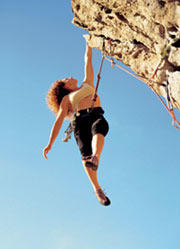|
英语阅读:Rock Climb
攀岩英语怎么说?
攀岩英语是:Rock Climb
by Jim Neumann
No one can really learn to rock climb from a newspaper, a video or the Internet. This article is intended as an introduction to rock climbing only. Seek instruction and places to practice first.
Why rock climb?
Adventure; freedom; go where no one has ever been; reach the top; enjoy nature; exercise; the excitement of newness. Or maybe you have your own reasons for wanting to learn. The beginning climber should always climb with an experienced leader, who will take care of runners, rope, sling, protection equipment, and the like. The beginning climber will be concerned with his/her own clothing, carabiners, and harness. All climbers should be concerned with the environment and courtesy to those who don’t climb.
Clothing
For the beginner, any clothing tough enough to take abrasion will suffice. Athletic shoes or hiking boots will allow you to sample the sport. If you fall in love with rock climbing, you will want to buy specialized rock climbing shoes, known as varappe or kletterscuhe. They have rubber synthetics that greatly enhance one’s friction on the rock.
Rope

Don’t use old, static ropes not manufactured for climbing. They are dangerous. Modern climbing ropes are laboratory-tested and “stretch” slightly after a fall. They are kernmantle constructed (outer sheath over a large number of long inner filaments), and although pricey, are used when sliding with less friction is desired. This preserves one’s body from bruises and pain at the end of any fall. No climbing rope has failed from a fall since World War II. They’re that good!
Carabiners
These are similar to large safety pins. Most climbers use a combination of the oval shape or the modified D-shape of Chouinard’s. Royal Robbins, author of Basic Rockcraft writes, “When buying a carabiner, check to make sure the spring action is smooth but not too strong, that the gate meshes freely, that there are no burrs, and that they are strong.”
Carabiners should test to at least 3,000 pounds. The responsible dealer will have information on carabiner strength. Ask before buying. Tying knots is beyond the scope of this article. You should learn the overhand knot, overhand loop, bowline, double-loop bowline, figure-of-eight loop, ring bend, and fisherman’s knot.
Belay
The belay consists of anchor, friction, and position.
1. Anchor
The most important element of the belay is the anchor. The anchor is a fixed point of attachment such as a tree, rock, or other “bomb-proof” attachment. Most belay accidents are caused through failure of the belayer. Therefore, it is important to use two anchors or slings when possible and test the anchor first by applying stress.
2. Friction
Friction is what keeps one alive if there is a fall. Sometimes the human body is used for friction. Many belay devices aid the belayer in protecting the climber above or below. The belayer should be secured to a fixed anchor in certain situations, i.e., the climber outweighs his belayer. The belayer protects the life of the climber at all times. Should his/her climber fall, one hand is always the “brake hand”. The other hand is the “guide hand”. It is imperative not to confuse these functions in the heat of a fall. Practice until holding with the proper hand is automatic.
3. Position
Robbins continues by writing that friction is useless unless the body is braced toward the direction of pull. Usually, this means a straight leg on the side of the rope going to the climber. The belayer places himself so as to minimize any adverse action upon the body, and generally faces the wall. Since it is not easy to judge the direction of force in a fall, much less the extent of force, the belayer must evaluate each situation and make use of the rock for the most secure position. Often he/she must be prepared for forces from various directions.
Conservation
Conservation of a route involves leaving it unchanged so others may enjoy nature and the climb. Use runners and “placed” protections whenever possible because they leave the rock intact. Pitons are not used for “free climbing” any more. They destroy the rock. Bolts are used only when necessary, and, only with permission of the land manager. Take your litter with you unless it is organic. Even orange rinds are slow to disintegrate and not eaten by animals.
Final Tips
The amount of strength one is able to conserve is far more important in rock climbing than the amount of strength one has. Move with a bit of spring and rhythm. Rest when you can. While resting, study the climb ahead. Use leg muscles for climbing, arms for balance and security.
Caution: loose rock is your enemy. It is impossible to tell whether a hold is solid by looking at it. All handholds should be tested. Handholds are struck with the heel of the hand; footholds are kicked for testing.
Rock climbing (not mountaineering as in climbing Mt. Everest) is a fast-growing sport for all ages and both sexes. Indoor “Rock Gyms” are popular in the metroplex for staying in shape. They are no substitute for outdoor climbing on “real” rock.
Jim Neumann, a resident of Arlington, Texas, is a long-time rock climber. 【已有很多网友发表了看法,点击参与讨论】【对英语不懂,点击提问】【英语论坛】【返回首页】
|